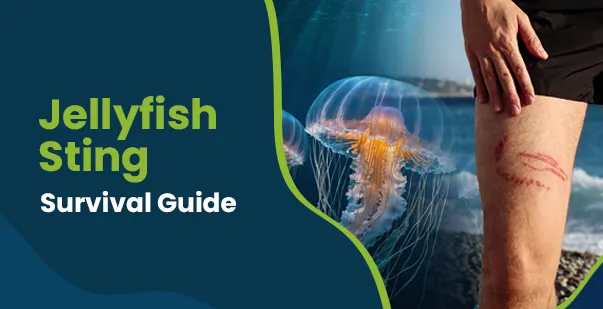A box jellyfish sting can turn a perfect beach day into a life-threatening emergency within minutes. These beautiful yet dangerous creatures are usually found primarily in the warm coastal waters of Australia and Southeast Asia. However, they can also be seen in the western Atlantic Ocean, including regions such as the Gulf of Mexico and along the eastern coast of North America.
They are responsible for more than 40-100 human fatalities in the past century, with many experts believing the actual number could be significantly higher due to underreporting in some regions. Despite their delicate appearance, box jellyfish pack one of nature’s most potent venoms. Victims have been known to go into cardiac arrest before even reaching the shore. So, let’s dive into what makes box jellyfish one of the ocean’s most formidable inhabitants.
What Does A Box Jelly Fish Look Like?
Box jellyfish have a distinctive cube-shaped bell body that makes them easily recognizable despite their transparent appearance. Unlike most jellyfish species, they are active swimmers with complex eyes and powerful tentacles that can deliver potentially lethal stings. Here are the key structural characteristics of box jellyfish:
Physical Structure
These remarkable creatures have translucent bodies. The actual box jellyfish size varies with species. The most dangerous species, Chironex fleckeri, can have a bell up to 30 cm (12 inches) across and tentacles extending up to 3 meters (10 feet). Smaller species may have bells as small as 10 cm (4 inches) with shorter tentacles. Despite their delicate appearance, they are among the most venomous marine creatures. Their bell-shaped body resembles a cubic box, which also gives box jellyfish its name. The body is surprisingly firm compared to other jellyfish species. Thus, they maintain their distinct shape while swimming through warm coastal waters.
Tentacle System
Each box jellyfish carries up to 15 tentacles from each of its four corners, which can extend up to 10 feet in length. When not in use, the tentacles retract, making them harder for prey and predators to detect. These tentacles are covered with millions of microscopic stinging cells called nematocysts. These cells are like tiny poison-filled harpoons that fire upon contact with any potential prey or unfortunate swimmer.
Venom Mechanism
Box jellyfish venom contains powerful toxins that attack the heart, nervous system, and skin cells. When their tentacles touch a target, specialized stinging cells called nematocysts fire microscopic harpoons that inject venom instantly. This venom punches holes in red blood cells, releasing potassium into the bloodstream, which can trigger heart failure within minutes.
Vision Capabilities
Perhaps their most fascinating feature is their advanced vision system. Box jellyfish possess 24 eyes arranged in clusters called rhopalia. These eyes are sophisticated enough to detect light, obstacles, and movement, which makes them efficient hunters. Unlike other jellyfish, they can actively pursue their prey rather than simply drifting with the currents.
Sensory System and Pain Perception
Unlike most marine creatures, box jellyfish have a unique sensory system. Their 24 eyes provide exceptional vision for their environment and help them detect prey. However, despite this advanced visual capability, they lack a centralized brain. Instead, their movements and responses are controlled by a decentralized nerve net.
If you are wondering do jellyfish feel pain, then the answer is no. Due to their simple nervous system, box jellyfish do not experience pain as humans do. They can react to stimuli, such as injury or touch but their responses are more reflexive than conscious.
Can A Box Jellyfish Sting Kill You?
Box jellyfish stings can be lethal. However, fatalities are relatively rare compared to the number of stings that occur. The severity depends on factors like the species involved, the amount of venom delivered, and the victim’s response.
Deadly Species and Statistics
Among the more than 50 species of box jellyfish, only eight have been identified as lethal to humans. The most notorious of these is Chironex fleckeri, known for its ability to deliver a fatal dose of venom. Other dangerous species include:
- Carukia barnesi (Irukandji jellyfish)
- Malo kingi
- Chironex yamaguchii
- Chironex fleckeri (Australian box jellyfish)
Most people who come across these species can survive when given immediate proper treatment.
Mechanism of Fatality
The primary cause of death from a box jellyfish sting is cardiotoxicity. The venom directly disrupts heart function, leading to abnormal rhythms and cardiac arrest. The effect is fast-acting, and in severe cases, especially in children or those with pre-existing conditions, death can occur within minutes.
Many victims report an immediate “electric shock” sensation upon contact with the tentacles. This is followed by excruciating pain, paralysis, and difficulty breathing. The overwhelming pain often causes shock or drowning before medical help arrives.
Anaphylactic Reactions
Some victims have severe allergic reactions, or anaphylaxis, to box jellyfish venom. This body-wide reaction leads to difficulty breathing, a drastic fall in blood pressure, and shock. Unless treated immediately by emergency services and epinephrine, the victim may die from anaphylaxis.
Long-term Effects
Even a sting that is not fatal can cause other harmful effects. The venom kills the tissue in the area where it was stung, leading to permanent scarring. Other long-term health problems include persistent pain and sensitivity where they are stung. A severe sting also has a large psychological impact.
How to Recognize A Box Jellyfish Sting?
A box jellyfish sting typically causes immediate and intense pain, often described as feeling like being branded with hot metal. The symptoms can range from severe local reactions to life-threatening conditions, depending on the exposure extent, which are explained as follows:
Immediate Symptoms
Within seconds of contact, victims experience excruciating pain accompanied by burning and stinging sensations. The affected skin quickly develops distinctive ladder-like welts or whip-like marks that follow the pattern of tentacle contact. These marks often appear red and raised, similar to severe burns.
Systemic Reactions
Beyond the initial sting site, victims may experience systemic symptoms including severe headache, nausea, and muscle spasms. In cases of significant exposure, people might develop difficulty breathing, chest pain, or irregular heartbeat. These symptoms can develop rapidly and require immediate medical attention.
Delayed Effects
Victims of box jellyfish stings can experience a range of delayed effects, particularly from the “Irukandji syndrome,” which is primarily associated with smaller species like Carukia barnesi. This syndrome can manifest hours after the initial sting, leading to severe pain, nausea, and other systemic symptoms. In contrast, the larger Chironex fleckeri is known for its immediate and often fatal effects, but it is less commonly linked to the delayed symptoms characteristic of Irukandji syndrome.
Read more: How to Manage a Respiratory Arrest?
First Aid Steps to Take for Box Jellyfish Stings
Immediate and correct first aid is important for a fatal box jellyfish sting, as the wrong treatment can worsen the condition. The primary goals are to deactivate remaining stinging cells, manage pain, and prevent life-threatening complications.
Initial Response
Remove the person from the water immediately while calling for emergency help. Pour vinegar liberally over the affected area for at least 30 seconds to neutralize undischarged nematocysts. Vinegar neutralizes the stinging cells (nematocysts) and prevents them from releasing more venom. Avoid rubbing the area or applying fresh water, as this can trigger more nematocysts to fire.
Tentacle Removal
After vinegar application, carefully remove any visible tentacles using tweezers or a gloved hand. Avoid rubbing or scraping the skin, as this can trigger nematocysts to fire additional venom into the wound. Never try to scrape them off with credit cards or other objects, as this can worsen the injury.
Pain Management
Apply hot water (110-113°F) to the sting area for 20-45 minutes, as heat helps neutralize the venom and provides pain relief. If hot water is unavailable, using hot packs or immersing the sting site in warm seawater can also be effective. The water should feel hot but not scalding to prevent burns.
Monitor Vital Signs
Check the person’s breathing and pulse regularly. Box jellyfish venom can cause heart failure or breathing difficulties. If they lose consciousness or stop breathing, start CPR immediately. Even if they seem stable, continue monitoring for signs of severe reaction.
Read more: 9 Basic Life-Saving Skills That Will Help You Save A Life
Medical Treatment for The Sting
Professional medical treatment for box jellyfish stings focuses on managing both immediate life-threatening complications and long-term effects. Treatment approaches vary based on the severity of the sting and the patient’s symptoms.
Emergency Care
Medical professionals may administer box jellyfish antivenom for severe cases, particularly with Chironex fleckeri stings. They’ll monitor vital signs and may provide cardiac support, including CPR if necessary. Oxygen therapy might be required for respiratory distress. It is important to note that antivenom is specifically used for severe cases involving Chironex fleckeri stings.
Pain Control
Healthcare providers often use a combination of local anesthetic injections and systemic pain medications. Opioid pain relievers are sometimes required for patients experiencing severe pain. The treatment plan is adjusted based on pain severity and the patient’s response.
Wound Management
Medical staff will clean and assess the sting site for signs of infection or tissue damage. If needed, topical or oral antibiotics will be prescribed. Infected wounds require antibiotic treatment, and patients should monitor for signs of secondary bacterial infections, such as redness, swelling, or pus formation.
What Are The Complications of Box Jelly Fish Stings
Box jellyfish stings can lead to severe complications beyond the initial pain and discomfort. These complications range from short-term inflammatory responses to potentially life-threatening conditions like Irukandji syndrome, requiring immediate medical intervention to prevent serious outcomes.
Irukandji Syndrome
This dangerous condition primarily occurs from Carukia barnesi stings but can also result from other box jellyfish species. Unlike immediate reactions, symptoms typically develop 20-30 minutes after the sting. Patients experience severe systemic reactions, including intense anxiety, dangerously high blood pressure, rapid heartbeat, and potential heart failure. The condition requires immediate emergency care.
Cardiovascular Complications
Some box jellyfish species, particularly Chironex fleckeri, can cause immediate and severe cardiac problems. The venom venom contains cardiotoxins that interfere with sodium and potassium ion channels, which can disrupt normal heart rhythm and cause extreme muscle contractions. This can lead to a dangerous increase in blood potassium levels and, without prompt treatment, may result in cardiac arrest within minutes of the sting.
Systemic Allergic Reactions
The venom can trigger severe allergic responses throughout the body, similar to anaphylaxis. Victims may experience difficulty breathing, widespread swelling, and a dangerous drop in blood pressure. These reactions can be life-threatening and require immediate administration of epinephrine and other emergency medications.
Long-term Skin Effects
Even after the acute phase passes, victims may face lasting skin complications. The sting sites often develop into severe dermatitis requiring ongoing treatment with topical medications. Many patients develop permanent scarring along the tentacle contact points, appearing as distinctive ladder-like or whip-marked patterns on the skin due to dermal necrotic properties of the venom.
Prevention of Box Jellyfish Sting
Preventing box jellyfish stings involves a combination of awareness, protective measures, and understanding their habitat patterns. Being proactive about safety can significantly reduce the risk of encounters with these dangerous creatures.
Protective Clothing
Wear protective swimwear like “stinger suits” or wet suits when swimming in known box jellyfish habitats. These specially designed suits cover most of your body and provide a barrier against tentacle contact. Regular pantyhose can also offer some protection in a pinch. In Australia, stinger nets are deployed in high-risk areas to minimize box jellyfish encounters and protect swimmers.
Environmental Awareness
Pay attention to warning signs and local advisories about jellyfish presence. Box jellyfish are often more abundant during certain seasons, typically during warmer months. Check with local authorities or lifeguards about current conditions before entering the water.
Safe Swimming Practices
Swim only in netted areas where available, especially in regions known for box jellyfish. Avoid swimming at dawn, dusk, or night when box jellyfish are more active. Stay close to shore, where you can quickly exit the water if needed.
Stay Safe in Box Jellyfish Waters With The Right Strategy!
Box jellyfish sting, though rare, is incredibly serious and demands immediate attention. The key to coexisting with these remarkable creatures lies in prevention and preparation. Always look for local warnings, swim in protected areas, and wear protective clothing when advised. Consider that while box jellyfish have earned their fearsome reputation, most victims survive when proper protocols are followed. Moreover, taking a certified first aid course could be your best investment in beach safety to handle marine emergencies. Your proactive step can save lives during those critical first minutes after a sting.
FAQs
- How deadly is a box jellyfish sting?
A box jellyfish sting can be extremely deadly due to its venom, which can cause heart failure, paralysis, or respiratory arrest within minutes. The sting delivers potent toxins that attack the heart, nervous system, and skin cells. Large stings or untreated cases are often fatal, especially in children and smaller individuals.
- What are the odds of surviving a box jellyfish sting?
Survival odds depend on the severity of the sting, how quickly first aid is administered, and access to medical care. Mild stings are survivable with proper treatment, but severe envenomations can cause death within 5 minutes if untreated. With prompt first aid (like vinegar application) and antivenom when needed, many people survive even serious stings
- Has anyone survived a box jellyfish sting?
Many people have survived box jellyfish stings, including several well-documented cases from Australia and Southeast Asia. In 2010, a 10-year-old girl survived a severe Chironex fleckeri sting due to immediate CPR and antivenom administration. Most survivors credit their recovery to quick emergency response and proper first aid protocols, though they often experience lasting scars.
- What happens after you get stung by a box jellyfish?
Upon contact, victims experience immediate, intense pain described as feeling like burning acid. Within minutes, the skin develops characteristic ladder-like welts where tentacles are touched. Depending on venom exposure, symptoms can progress to include difficulty breathing, heart problems, and severe muscle cramps. Without treatment, severe stings can cause unconsciousness and cardiac arrest within minutes.









